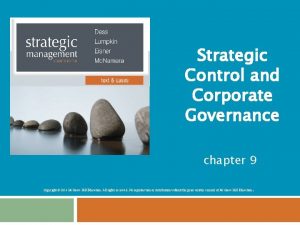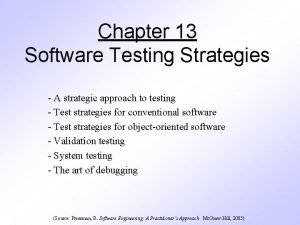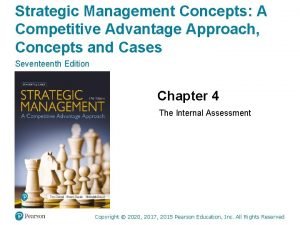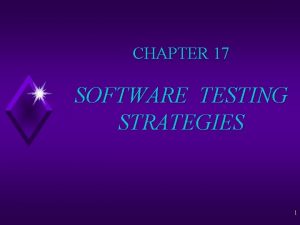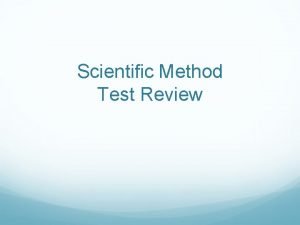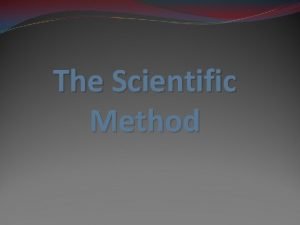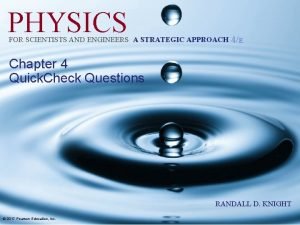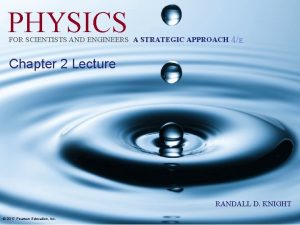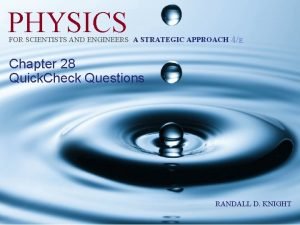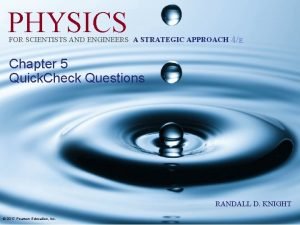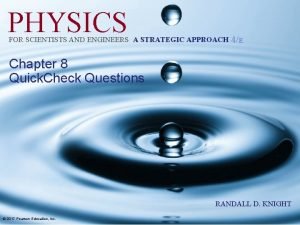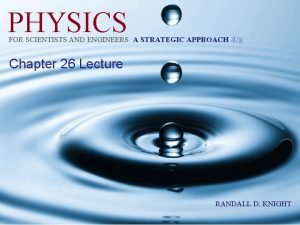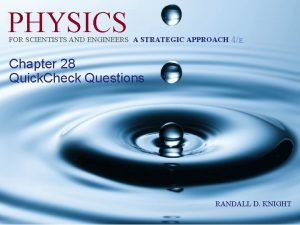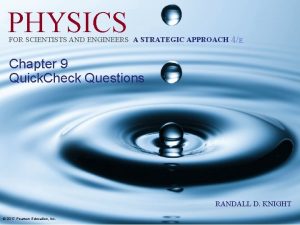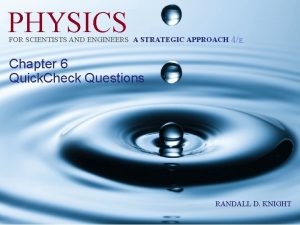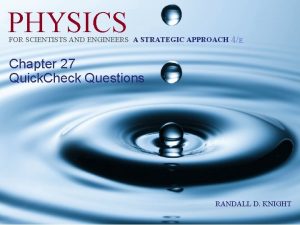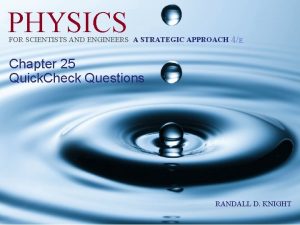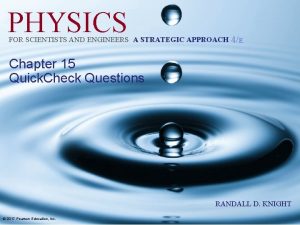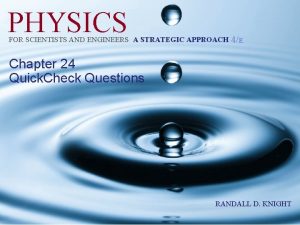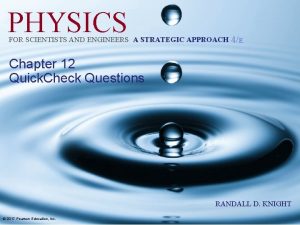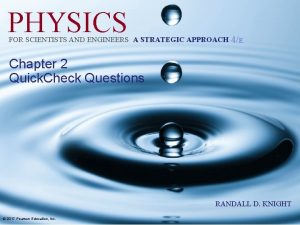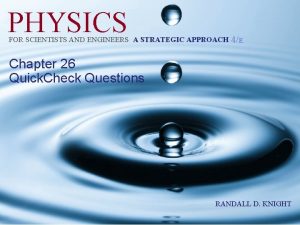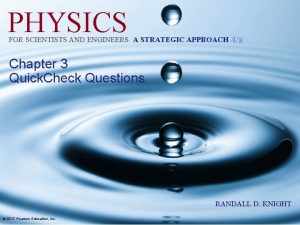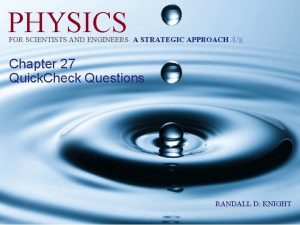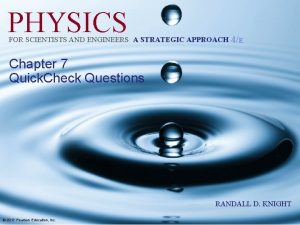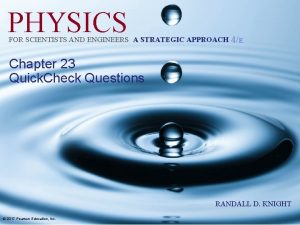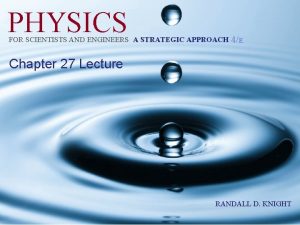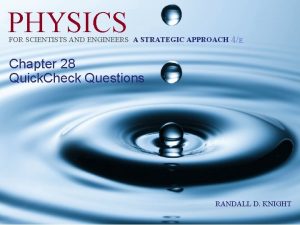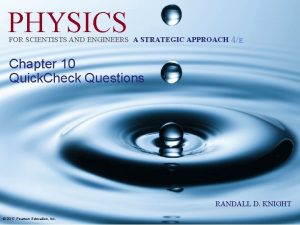PHYSICS FOR SCIENTISTS AND ENGINEERS A STRATEGIC APPROACH





























- Slides: 29

PHYSICS FOR SCIENTISTS AND ENGINEERS A STRATEGIC APPROACH 4/E Chapter 23 Quick. Check Questions RANDALL D. KNIGHT © 2017 Pearson Education, Inc.

Quick. Check 23. 1 What is the direction of the electric field at the dot? E. None of these. © 2017 Pearson Education, Inc. Slide 23 -2

Quick. Check 23. 1 What is the direction of the electric field at the dot? E. None of these. © 2017 Pearson Education, Inc. Slide 23 -3

Quick. Check 23. 2 What is the direction of the electric field at the dot? E. The field is zero. © 2017 Pearson Education, Inc. Slide 23 -4

Quick. Check 23. 2 What is the direction of the electric field at the dot? E. The field is zero. © 2017 Pearson Education, Inc. Slide 23 -5

Quick. Check 23. 3 When r >> d, the electric field strength at the dot is A. B. C. D. E. © 2017 Pearson Education, Inc. Slide 23 -6

Quick. Check 23. 3 When r >> d, the electric field strength at the dot is A. B. C. Looks like a point charge 4 Q at the origin. D. E. © 2017 Pearson Education, Inc. Slide 23 -7

Quick. Check 23. 4 Two protons, A and B, are in an electric field. Which proton has the larger acceleration? A. Proton A B. Proton B C. Both have the same acceleration. © 2017 Pearson Education, Inc. Slide 23 -8

Quick. Check 23. 4 Two protons, A and B, are in an electric field. Which proton has the larger acceleration? Stronger field where field lines are closer together. A. Proton A B. Proton B C. Both have the same acceleration. © 2017 Pearson Education, Inc. Weaker field where field lines are farther apart. Slide 23 -9

Quick. Check 23. 5 An electron is in the plane that bisects a dipole. What is the direction of the electric force on the electron? E. The force is zero. © 2017 Pearson Education, Inc. Slide 23 -10

Quick. Check 23. 5 An electron is in the plane that bisects a dipole. What is the direction of the electric force on the electron? E. The force is zero. © 2017 Pearson Education, Inc. Slide 23 -11

Quick. Check 23. 6 If 8 n. C of charge are placed on the square loop of wire, the linear charge density will be A. 800 n. C/m B. 400 n. C/m C. 200 n. C/m D. 8 n. C/m E. 2 n. C/m © 2017 Pearson Education, Inc. Slide 23 -12

Quick. Check 23. 6 If 8 n. C of charge are placed on the square loop of wire, the linear charge density will be A. 800 n. C/m B. 400 n. C/m C. 200 n. C/m D. 8 n. C/m E. 2 n. C/m © 2017 Pearson Education, Inc. Slide 23 -13

Quick. Check 23. 7 A flat circular ring is made from a very thin sheet of metal. Charge Q is uniformly distributed over the ring. Assuming w << R, the surface charge density η is A. Q/2πRw B. Q/4πRw C. Q/πR 2 D. Q/2πR 2 E. Q/πRw © 2017 Pearson Education, Inc. Slide 23 -14

Quick. Check 23. 7 A flat circular ring is made from a very thin sheet of metal. Charge Q is uniformly distributed over the ring. Assuming w << R, the surface charge density η is A. Q/2πRw B. Q/4πRw C. Q/πR 2 D. Q/2πR 2 E. Q/πRw © 2017 Pearson Education, Inc. The ring has two sides, each of area 2πRw. Slide 23 -15

Quick. Check 23. 8 At the dot, the y-component of the electric field due to the shaded region of charge is A. B. C. D. E. © 2017 Pearson Education, Inc. Slide 23 -16

Quick. Check 23. 8 At the dot, the y-component of the electric field due to the shaded region of charge is A. B. C. D. E. © 2017 Pearson Education, Inc. Slide 23 -17

Quick. Check 23. 9 Two protons, A and B, are next to an infinite plane of positive charge. Proton B is twice as far from the plane as proton A. Which proton has the larger acceleration? A. Proton A B. Proton B C. Both have the same acceleration. © 2017 Pearson Education, Inc. Slide 23 -18

Quick. Check 23. 9 Two protons, A and B, are next to an infinite plane of positive charge. Proton B is twice as far from the plane as proton A. Which proton has the larger acceleration? A. Proton A B. Proton B C. Both have the same acceleration. © 2017 Pearson Education, Inc. Slide 23 -19

Quick. Check 23. 10 Three points inside a parallel-plate capacitor are marked. Which is true? A. E 1 > E 2 > E 3 B. E 1 < E 2 < E 3 C. E 1 = E 2 = E 3 D. E 1 = E 3 > E 2 © 2017 Pearson Education, Inc. Slide 23 -20

Quick. Check 23. 10 Three points inside a parallel-plate capacitor are marked. Which is true? A. E 1 > E 2 > E 3 B. E 1 < E 2 < E 3 C. E 1 = E 2 = E 3 D. E 1 = E 3 > E 2 © 2017 Pearson Education, Inc. Slide 23 -21

Quick. Check 23. 11 A proton is moving to the right in a vertical electric field. A very short time later, the proton’s velocity is © 2017 Pearson Education, Inc. Slide 23 -22

Quick. Check 23. 11 A proton is moving to the right in a vertical electric field. A very short time later, the proton’s velocity is © 2017 Pearson Education, Inc. Slide 23 -23

Quick. Check 23. 12 Which electric field is responsible for the proton’s trajectory? A. © 2017 Pearson Education, Inc. B. C. D. E. Slide 23 -24

Quick. Check 23. 12 Which electric field is responsible for the proton’s trajectory? A. © 2017 Pearson Education, Inc. B. C. D. E. Slide 23 -25

Quick. Check 23. 13 Which dipole experiences no net force in the electric field? A. Dipole A B. Dipole B C. Dipole C D. Both dipoles A and C C. E. All three dipoles © 2017 Pearson Education, Inc. Slide 23 -26

Quick. Check 23. 13 Which dipole experiences no net force in the electric field? A. Dipole A B. Dipole B C. Dipole C D. Both dipoles A and C C. E. All three dipoles © 2017 Pearson Education, Inc. Slide 23 -27

Quick. Check 23. 14 Which dipole experiences no net torque in the electric field? A. Dipole A B. Dipole B C. Dipole C C. D. Both dipoles A and C E. All three dipoles © 2017 Pearson Education, Inc. Slide 23 -28

Quick. Check 23. 14 Which dipole experiences no net torque in the electric field? A. Dipole A B. Dipole B C. Dipole C C. D. Both dipoles A and C E. All three dipoles © 2017 Pearson Education, Inc. Slide 23 -29
 Tirole
Tirole Strategic management and strategic competitiveness
Strategic management and strategic competitiveness Strategy analysis and choice largely involves making
Strategy analysis and choice largely involves making Virtual circuit switching example
Virtual circuit switching example Deep learning approach and surface learning approach
Deep learning approach and surface learning approach Strategic fit vs strategic intent
Strategic fit vs strategic intent Incremental approach in strategic management
Incremental approach in strategic management Strategic control and corporate governance
Strategic control and corporate governance Strategic choice approach
Strategic choice approach A strategic approach to software testing
A strategic approach to software testing Strategic management a competitive advantage approach
Strategic management a competitive advantage approach A strategic approach to software testing
A strategic approach to software testing Commander approach in strategic management
Commander approach in strategic management After the experiment scientists organize and the data
After the experiment scientists organize and the data Diagrams tables and graphs are used by scientists mainly to
Diagrams tables and graphs are used by scientists mainly to Modern physics vs classical physics
Modern physics vs classical physics University physics with modern physics fifteenth edition
University physics with modern physics fifteenth edition Ia physics ideas
Ia physics ideas Formuö
Formuö Typiska drag för en novell
Typiska drag för en novell Nationell inriktning för artificiell intelligens
Nationell inriktning för artificiell intelligens Ekologiskt fotavtryck
Ekologiskt fotavtryck Shingelfrisyren
Shingelfrisyren En lathund för arbete med kontinuitetshantering
En lathund för arbete med kontinuitetshantering Särskild löneskatt för pensionskostnader
Särskild löneskatt för pensionskostnader Tidbok
Tidbok A gastrica
A gastrica Densitet vatten
Densitet vatten Datorkunskap för nybörjare
Datorkunskap för nybörjare Tack för att ni lyssnade bild
Tack för att ni lyssnade bild







